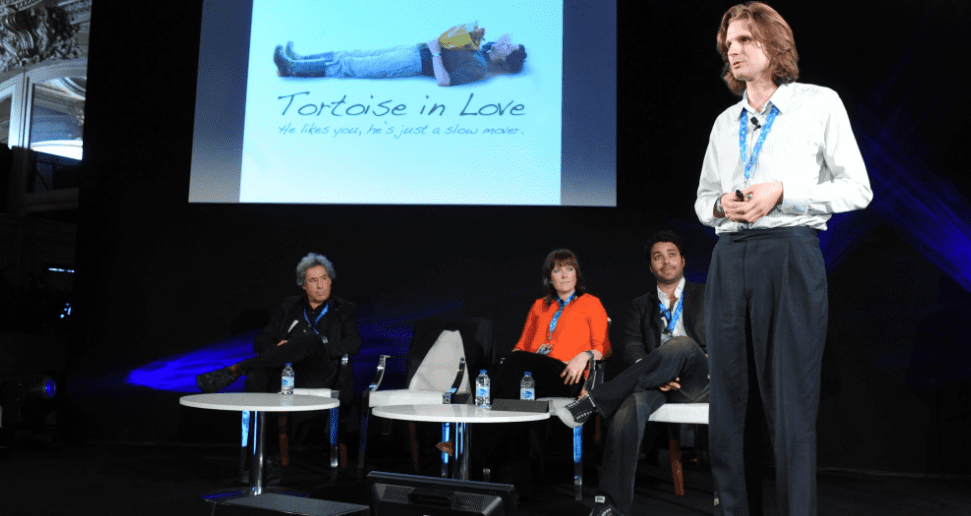From left to right: Kino Lorber CEO Richard Lorber, Channel 4 TV commissioning editor for education Dr. Jo Twist, East London Productions co-founder Pasa Mustafa – who also served as moderator – and Immense Productions LLC producer Steffan Aquarone.
Independent film company Kino Lorber take a social approach to bringing good films to audiences that want them. You’ve heard of DIY (do it yourself)? Their philosophy is DIT (do it together). For them, crowdfunding is a bridge uniquely tailored to documentary filmmaking. Richard Lorber’s brief presentation on why, and how, is a good primer for anybody seeking financial support.
One thing to remember about crowdfunding is “it’s not an investment-based business. It’s micro-patronage,” said Lorber. The contributions of the people who help you are pure grants, he stressed. There is no expected return on investment beyond, at most, a gift (a signed copy of the film or the screenplay), a chance to meet the director, or just the opportunity to see the final product in a public space, knowing you helped bring it there.
Crowdfunding works much like the documentary production process does. It involves:
- A charismatic, impassioned person telling a personal story
- Collaboration for a purpose
- The process being perceived and felt as a mission
And documentaries also make a good match for crowdsourced support. Both tend to be:
- Constituency focused: aggregating self-selected audiences
- Activist or advocacy themed: embedded with an inherent cause
- Interwoven with a passionate personal tale
What are the models to look at? The US market includes three crowdfunding platforms that did a good job of establishing themselves and making it easy for people to express their desires, donate and self-organise:
- Kickstarter – by far the largest, and open to crowdsourcing funds for any project, not just films. The thing is, it’s all or nothing: if you meet your funding goals, you get the money; if not, you get nothing. Filmmakers, though, seem to enjoy this tension.
- IndieGoGo – you keep what you raise.
- RocketHub – Lorber labels this one “a cultural revolution.” I take that to mean it is the most “indie” of them all.
A few known film projects that have sought funding on Kickstarter:
- “My Reincarnation,” seeded by producer/director Jennifer Fox. The goal is $50,000; she has raised $35,000 so far and has 55 more days to go.
- “The Banjo Project,” seeded by producer Michael Kantor. The goal was $25,000; he raised $46,000. For the record, Kino hopes to acquire licensing rights to this. The film shows promise and included the heavy participation of Steve Martin, himself an avid banjo player.
- “Asexuality,” seeded by producer/director Angela Tucker for a $10,000 goal. She has raised $11,000.
It is key to remember that at the heart of crowdsourced funding is users’ desire to financially help you because the story or the cause are so compelling, or because they feel some other allegiance to you. Our other speakers gave lovely examples of this.
Dr. Jo Twist talked briefly about crowdsourced funding’s power for drawing attention, using the examples of:
- BBC Switch’s September 2009 experiment/documentary, Chartjackers, which leveraged four YouTube legends to crowdsource a pop song and bring it to #1 on the UK charts. Proceeds went to help needy children, which was nice, but much was alluded to the fact that fans – mostly girls – had been following these boys since the birth of YouTube in ’05. Their loyalty, and the boys’ reciprocation, made them incredibly mobile.
- Battlefront, which drove young people to channel their passions into supporting worthy causes.
When constructing contests like these, Twist emphasised that reward is key, but not too much: insert a bit of randomness into the equation, like slot machine vendors. This way, users keep pulling that lever in hopes of getting lucky.
Finally, Steffan Aquarone discussed his experience producing “Tortoise in Love“, a romantic comedy almost entirely funded by, and enacted by, the 2000-person English village of Kingston Bagpuize and Southmoor.
Villagers had the option of becoming “B” stock share holders (with directors and trust holding “A” stock). This way, the village itself had a stake in how the film fared, making them more amenable to participation — very much a community effort. In total, with the inclusion of outside funding, the project raised £255,000 … of which £160,000 consisted of purchases of “B” stock (63% of total funding).
Marketing and fundraising efforts included direct mail to highly targeted potential angels, social network outreach to friends and family, a website, and a village newsletter. The latter became the most powerful catalyst of all, raising the most money.





2 Comments
Just wanted to thank you for your attention to The Banjo Project and its successful Kickstarter campaign. For the record, I am the producer and fundraiser for The Banjo Project since the start of production in 2002. I created the Kickstarter campaign with my co-producer and Music Director, Tony Trischka. Michael Kantor is the Executive Producer.
love the information, here in Colombia is so dificult to get resourses.